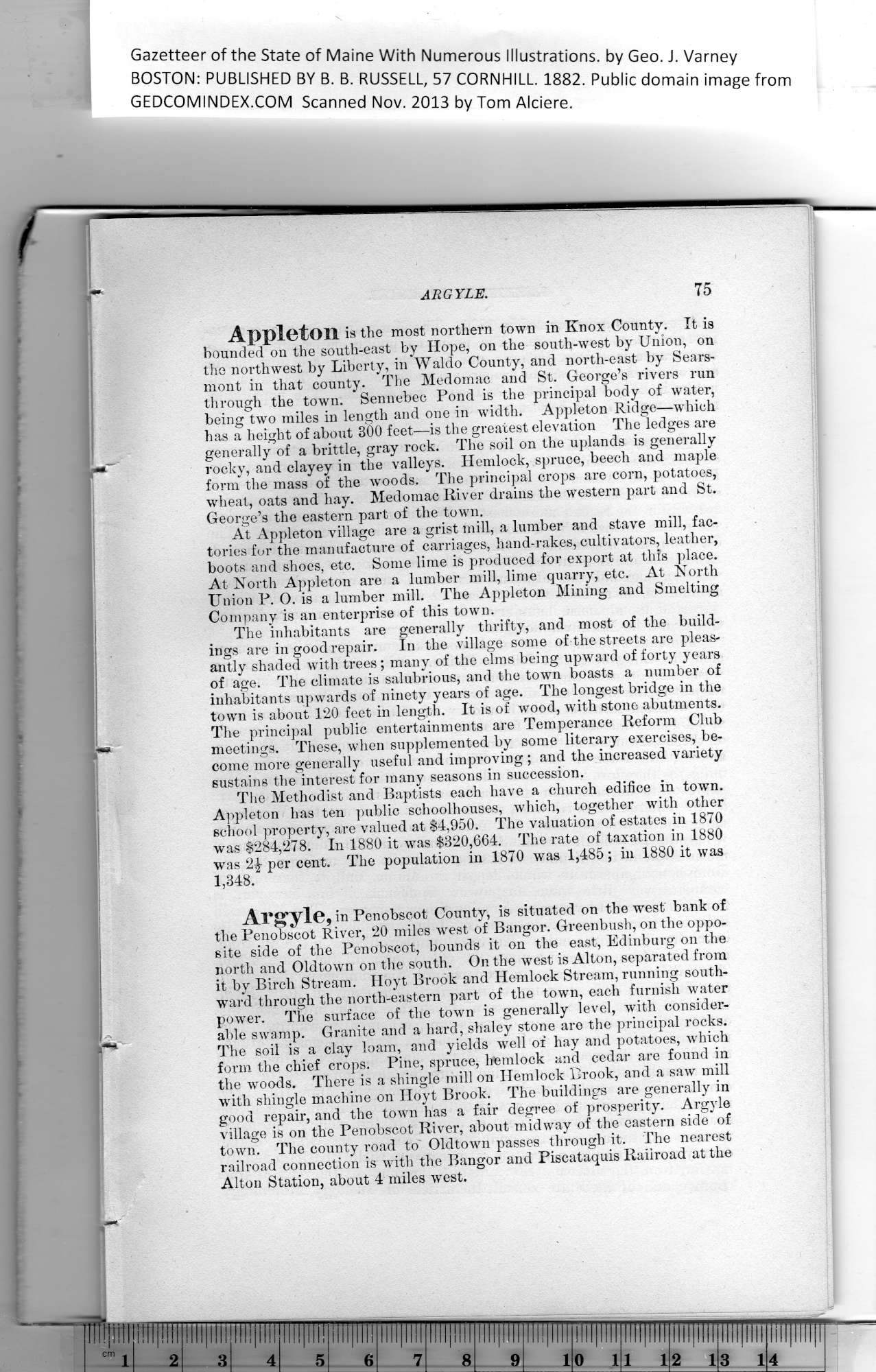|
ARGYLE.
Appleton is the most northern town in Knox County. It is
hounded on the south-east by Hope, on the south-west by Union, on
the northwest by Liberty, in Waldo County, and north-east by Sears-
mont in that county. The Medomac and St. George’s rivers run
through the town. Sennebec Pond is the principal body of water,
being two miles in length and one in width. Appleton Ridge—which
has a height of about 300 feet—is the greatest elevation The ledges are
generally of a brittle, gray rock. The soil on the uplands is generally
rocky, and clayey in the valleys. Hemlock, spruce, beech and maple
form the mass of the woods. The principal crops are corn, potatoes,
wheat, oats and hay. Medomac River drains the western part and St.
George’s the eastern part of the town.
At Appleton village are a grist mill, a lumber and stave mill, fac-
tories for the manufacture of carriages, hand-rakes, cultivators, leather,
boots and shoes, etc. Some lime is produced for export at this place.
At North Appleton are a lumber mill, lime quarry, etc. At North
Union P. O. is a lumber mill. The Appleton Mining and Smelting
Company is an enterprise of this town.
The inhabitants are generally thrifty, and most of the build-
ings are in good repair. In the village some of the streets are pleas-
antly shaded with trees; many of the elms being upward of forty years
of age. The climate is salubrious, and the town boasts a number of
inhabitants upwards of ninety years of age. The longest bridge in the
town is about 120 feet in length. It is of wood, with stone abutments.
The principal public entertainments are Temperance Reform Club
meetings. These, when supplemented by some literary exercises, be-
come more generally useful and improving ; and the increased variety
sustains tbe interest for many seasons in succession.
The Methodist and Baptists each have a church edifice in town.
Appleton has ten public schoolhouses, which, together with other
school property, are valued at $4,950. The valuation of estates in 1870
was $284,278. In 1880 it was $320,664. The rate of taxation in 1880
was 2^- per cent. The population in 1870 was 1,485; in 1880 it was
1,348.
Argyle, in Penobscot County, is situated on the west bank of
tbe Penobscot River, 20 miles west of Bangor. Greenbush, on the oppo-
site side of tbe Penobscot, bounds it on the east, Edinburg on the
north and Oldtown on the south. On the west is Alton, separated from
it by Birch Stream. Hoyt Brook and Hemlock Stream, running south-
ward through the north-eastern part of the town, each furnish water
power. The surface of the town is generally level, with consider-
able swamp. Granite and a hard, shaley stone are the principal rocks.
The soil is a clay loam, and yields well of hay and potatoes, which
form the chief crops. Pine, spruce, hemlock and cedar are found in
the woods. There is a shingle mill on Hemlock Brook, and a saw mill
with shingle machine on Hoyt Brook. The buildings are generally in
good repair, and the town has a fair degree of prosperity. Argyle
village is on the Penobscot River, about midway of the eastern side of
town. The county road to Oldtown passes through it. The nearest
railroad connection is with the Bangor and Piscataquis Railroad at the
Alton Station, about 4 miles west.
PREVIOUS PAGE ... NEXT PAGE
This page was written in HTML using a program written in Python 3.2
|
